Some surfers have little idea on how to wax a surfboard correctly, keeping their surfing potential under constraint. Surfing on surfboards would have been easy if they didn’t get slippery and less adhesive on the feet when wet.
There is nothing as frustrating as falling off your surfboard frequently and, for a beginner, it may be uninspiring. For intermediate and advanced riders, not being able to show off skills and stunts can be provoking.
Waxing your surfboard can reduce these awkward situations significantly; hence, you should read this article to learn about this. If you haven’t been waxing correctly, you should take your time to follow closely.
Table of Contents
What Is Surf Wax?
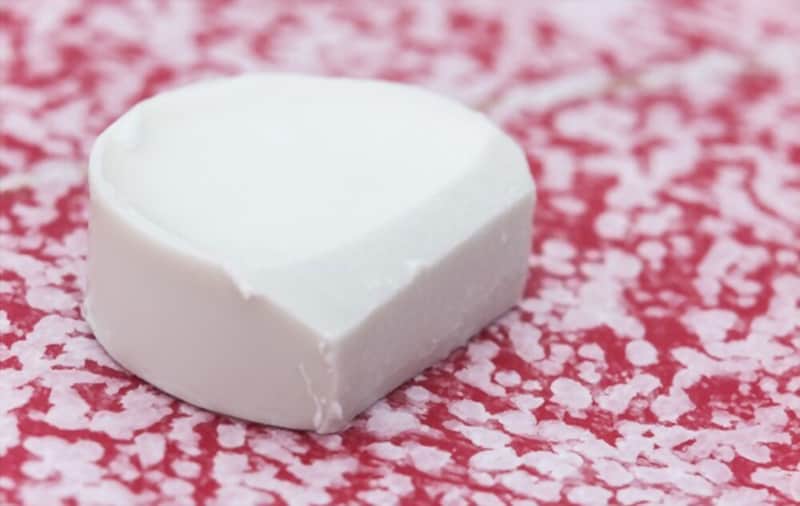
Characteristically, they are sticky in nature and, when employed in waxing, they provide additional grip on surfboards. They come in different types and classifications which will be discussed going forward in this article.
Is Waxing a Surfboard Necessary?
Traction (while surfing) is very essential regardless of your experience. While dry surfboards have high traction, this attribute flips almost instantly when they are wet. So what happens next since the body weight is more at the trunk?
Without a doubt, you are more likely to fall off the surfboard. Waxing your surfboard correctly before jumping into action can enhance your grip on the board. The extra traction gained allows more control, balance, and confidence.
Furthermore, you are safer by waxing your surfboard, and, interestingly, it is simple, straightforward, and inexpensive. Now you know why waxing is necessary, let’s move on to what you need to wax a surfboard.
Related: Top 15 Best Traction Pads for All Surfboards in 2023
What You Will Need to Wax a Surfboard?
As stated earlier, waxing your surfboards isn’t a difficult task, but without the right materials, it can be pretty ineffective. As a result, you need to be careful of what you buy and your budget, particularly when buying surf wax.
1. Base Coat
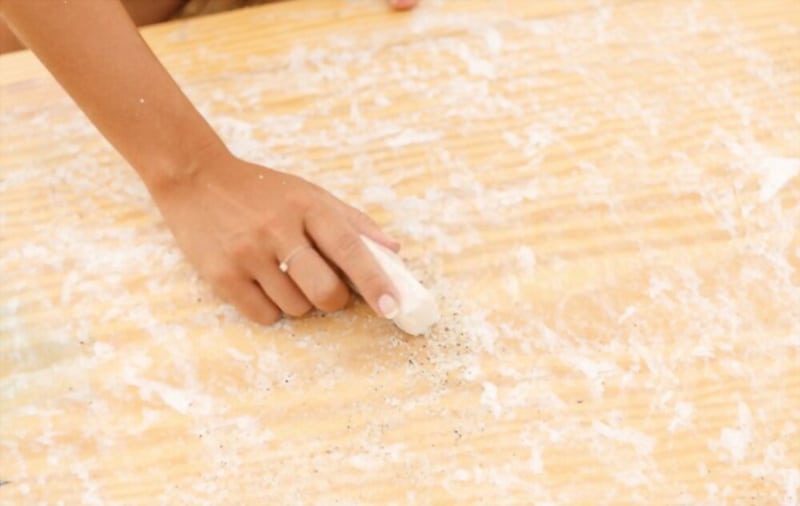
While some surfers may ignore the use of base coats, it isn’t really a good idea. The absence of a base coat can cause the topcoat to peel out faster. Of course, that means wastage and extra waxing (money).
2. Top Coat
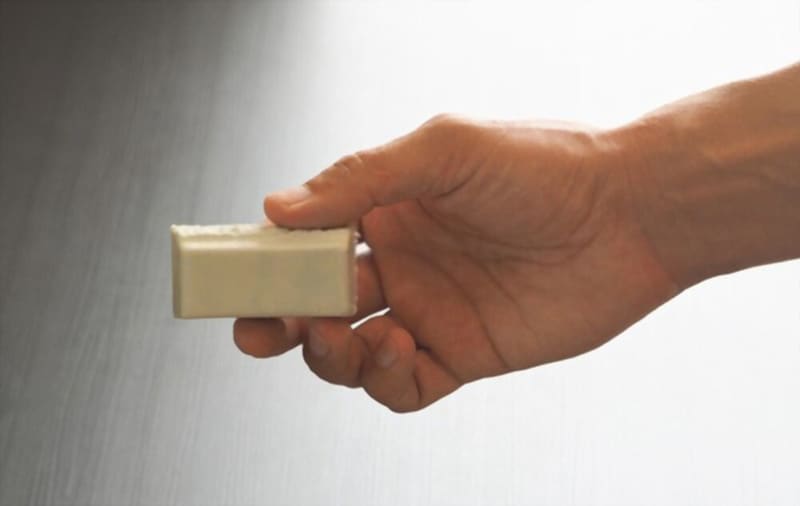
However, they are sensitive to temperature and heat. Before settling for a particular topcoat, you must consider your surf location else you suffer poor performance or waste money.
As seen in the table below, the topcoats are classified based on their temperature tolerance into cold, cool, warm and tropical. The cold coats are best for chilly locations while the tropical coats perform well in hot climes.
| Water Temperature | Less than 60°F (15°C) | 58.5°F – 67.5°F (14°C – 20°C) | 64°F – 74°F (18°C – 23°C) | More than 74°F (23°C) |
| Suitable Wax Type | Cold | Cool | Warm | Tropical |
3. Cleaning Accessories
In order to get excellent waxing, you must not neglect to clean your surfboard thoroughly. Dirt, oil, and foreign particles may cause your wax to fix improperly. A piece of cloth and mild soap should do a new surfboard.
In a different situation for a previously waxed surfboard. Getting an old wax from your board can be difficult. However, a wax comb (or plastic scraper), denatured alcohol and wax dissolver (liquid) should help out.
4 Simple Steps to Wax a Surfboard
Let’s get into business. Ensure you’ve purchased a good surfboard based on your experience and body size. Also, make sure you purchase the best surf wax available. Once that’s sorted out you can start waxing with the following steps.
1. Clean the Surfboard
There are two instances – a new surfboard and a previously waxed one. For a new surfboard, it is nothing serious. You only need to clean it gently with a mild soap, warm water, and a piece of clean cloth.
For a previously waxed surfboard, you need to go the extra mile. Keeping back old wax can cause the new layer to peel off easily, leaving useless layers of wax. You won’t enjoy your performance and money is wasted.
Acknowledging that it can be frustrating to get old wax off the deck, you should clean a few hours to surf. To remove the old wax, you can make use of a wax comb (or a plastic scraper).
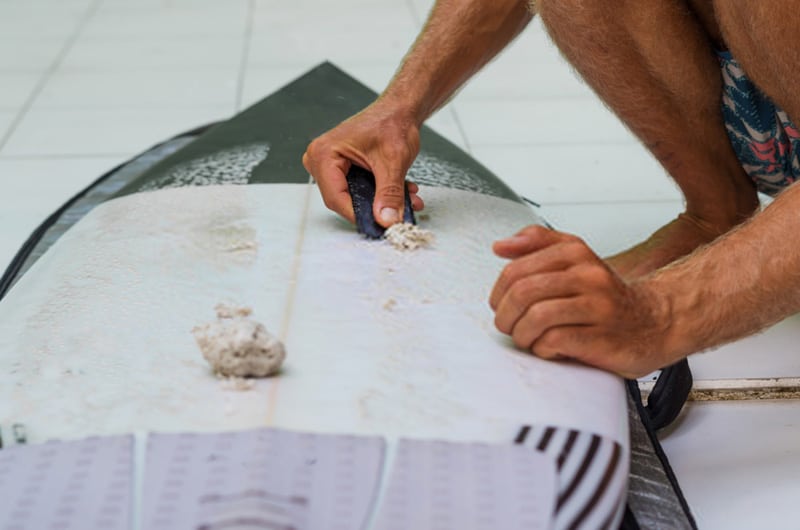
You must scrape off every wax, but gently to avoid damaging your surfboard. Once you have taken a larger percentage out, you can finish up with the wax remover or denatured alcohol. You have a shining surfboard when completed.
2. Identify Where to Put Your Wax
The way you wax a surfboard varies but you should never wax the bottom as it can make it less responsive. The deck is what is important. If you are using a longboard, you need to wax all the deck.
For a small surfboard, you need to wax from the center to the tail. Except if it is a longboard, you should wax only the areas where your feet will be.
You also need to wax the rails and areas where your hands will hold. Please note that waxing should be done indoors to avoid melting the wax.
3. Apply the Base Coat
The primary reason for a base coat is to ensure that the main (top) wax adheres properly to the surfboard. Without it, your topcoat may flake off pretty easily and you have to spend avoidably more.
Base coats are harder but they stick well on clean surfboards. They may feel difficult to apply anyway due to their texture; therefore, you need to press into the board strongly. Also, they last long and cannot be used alone.
Now, another thing to note is your waxing pattern. There are four common patterns – circle, cross-hatch, straight line, and freestyle. In the circle pattern, you have to rub the required areas in a circular motion.
The crosshatch pattern requires you to draw diagonal lines across the surfboard from either side to form a “net”. The straight-line pattern is similar to the crosshatch, but it runs nose to tail and side to side on a straight line.
For the freestyle, you can choose any motion and direction. However, the first three are considered best. They allow even distribution of wax, but the circular pattern is considered faster. Using any of the waxing patterns, you apply correctly.
As you rub the surf wax, it keeps accumulating and you should keep pressing boldly till small bumps appear. A well-lit work area will allow you to see areas that need more waxing. Once it’s even, you are good to go.
4. Apply the Top Coat
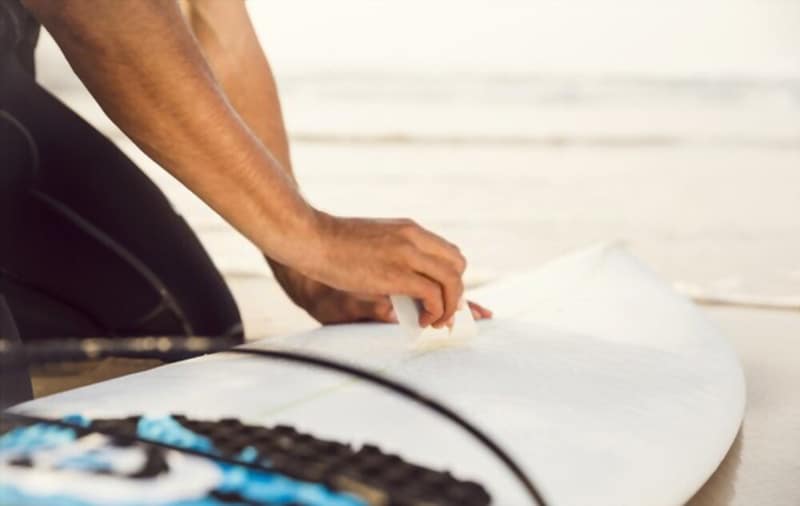
Just like you applied your base coat, follow the same pattern but, due to its texture, apply it gently for uniformity. Also, you should not exceed the areas you’re expected to wax.
5. One More Thing
Once you are done, you can improve the waxing by pouring cold water on it. This helps to harden the wax and increase its adhesion. After some minutes (say five), you can start surfing.
Putting some wax on your hands can allow better grip in case you want to have a nice time with paddle boards or wake surfboards.
For a run-through of these guidelines, you should spare some minutes to watch the video below. It gives you a more practical approach to buttress your understanding.
How Often Do I Need to Apply Surf Wax?
If you applied surf wax properly, it should last you a long time. You can top up your topcoat every time you want to surf. At least, you get to enjoy a fresh feel on your feet.
In case you do not need an extra topcoat, you can use a wax comb to scratch slightly the board, exposing some fresh wax. Nevertheless, you should clean your surfboard and apply fresh waxing every two to three months.
You need to remove the wax from your surfboard before reapplying. The old wax may have accumulated dirt, hair, etc. Of course, you want to keep your surfboard as fresh as possible.
You should take note that the longevity of your waxing is dependent on the quality of the wax. The temperature of your surf location (and surf wax compatibility) is also an important factor.
Frequently Asked Questions (FAQs)
Do you have questions yet unanswered in the course of the article? Do you have issues getting the best out of your surfboard via waxing? Kindly check out some of the frequently asked questions I answered below.
Can You Surf Without Wax?
Yes, you can surf without wax but I wouldn’t do that if I were you. An “unwaxed” surfboard can be difficult to wield especially when wet. Waxing gives you the traction and grip to keep you from falling off the surfboard frequently.
How Long Does Surf Wax Last?
Generally, a properly wax surfboard will need no re-waxing for three months. This figure is also dependent on your surfing intensity and wax quality. Therefore, it should last two to three months.
Should I Wax My Foam Surfboard?
Yes, you should be waxing your foam surfboard in line with the guidelines discussed above. If you are serious about developing faster as a surfer, you should consider waxing.
Do You Wax the Bottom of a Surfboard?
No! You do not need to apply wax on the bottom of your surfboard. The deck is where the grip is needed and not underneath the board. You must not wax damaged areas on the board as well.
Conclusion
Waxing your surfboard correctly can bring the little difference and motivation you need to unlock your surfing potential. It helps to increase your traction, fostering better performance. Therefore, knowing how to wax a surfboard is an essential course to excel in.
The determinants of your waxing quality are your materials and application methods. Never wax your surfboard without a base coat or prior cleaning. Also, you must ensure to pick the best topcoat for your surf location.
I strongly believe that by now you have a full grasp of why and how to wax a surfboard. It would be best to help other surfers around develop faster. Click on the social media buttons to share this knowledge with them.
Do you want to share your opinions, make comments or have some questions? Kindly forward them to me via the comment section down this page. Happy surfing!
